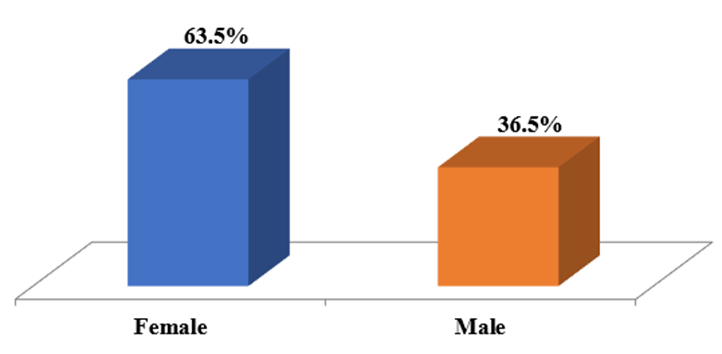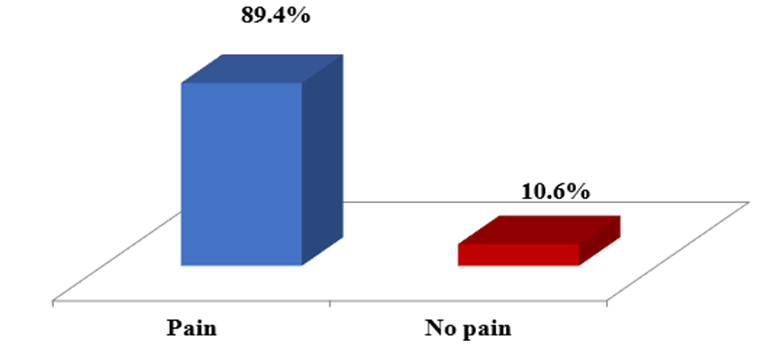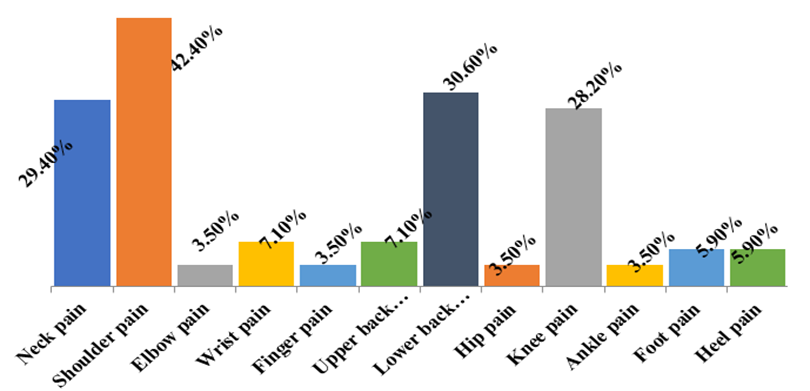Research Article
Pattern of Musculoskeletal Pain among Type 2 Diabetic Patients attending Selected Hospitals in Bangladesh
1Chief Consultant (Physiotherapy), Dinajpur Paralysis O Protibondhider Punorbason Kandro Hospital, Bangladesh.
2Assistant Medical Coordinator, Medecins Sans Frontieres- Bangladesh Mission.
3Final Year MBBS Student, Anwer Khan Modern Medical College.
4Intern Doctor, Anwer Khan Modern Medical College Hospital.
5Associate Professor, Department of Public Health, Fareast International University.
*Corresponding Author: Md Monoarul Haque, Associate Professor, Department of Public Health, Fareast International University.
Citation: Islam M S, Sharmeen A, Hasan N J, Labib A, Haque M M. (2024). Pattern of Musculoskeletal Pain among Type 2 Diabetic Patients attending Selected Hospitals in Bangladesh. Journal of Endocrinology and Diabetes Research, BioRes Scientia Publishers. 2(2):1-5. DOI: 10.59657/2996-3095.brs.24.015
Copyright: © 2024 Md Monoarul Haque, this is an open-access article distributed under the terms of the Creative Commons Attribution License, which permits unrestricted use, distribution, and reproduction in any medium, provided the original author and source are credited.
Received: April 18, 2024 | Accepted: May 04, 2024 | Published: May 13, 2024
Abstract
Musculoskeletal disorders are common in type 2 diabetes subjects and examination particular regions of the hands, the joints, shoulders and feet, as well as the skeleton should be included in the evaluation of patients with diabetes mellitus. In Bangladesh it is more severe. The aim of the study was to assess pattern of musculoskeletal pain among type 2 diabetes patients. The study population was consisting of male and female who were suffering from type-2 diabetics in different government and private hospitals in Bangladesh. The duration of study was 6 months. Samples were selected purposively to interview the study population considering the inclusion and exclusion criteria. An interviewer administered structured questionnaire was designed to collect information. The average age of the respondent was 50.76 years. Female study subjects were quite double than male. About 89.4% participants were suffering from musculoskeletal pain. Shoulder, neck, lower back and knee were the prevalent zone of pain. Severe and worst pain were dominant in nature. Highly significant association was found between age and musculoskeletal pain.
Keywords: musculoskeletal pain; diabetic patients
Introduction
Diabetes mellitus, a worldwide high prevalence disease, the prevalence of diabetes for all age groups worldwide was estimated to be of 2.8% in 2000 and 4.4% in 2030. The total number of people with diabetes is projected to raise from 171 million in 2000 to 366 million in 2030 [1]. Diabetes mellitus affects connective tissues in many ways and causes different alterations in periarticular and skeletal systems. Several musculoskeletal disorders have been described in these patients which can be divided into three categories: disorders which represent intrinsic complications of diabetes, such as limited joint mobility, disorders with an increased incidence among diabetes such as shoulder capsulitis and finally disorders for which a possible association with diabetes has been proposed but not proven yet, such as osteoarthritis and carpal the tunnel syndrome [2]. Epidemiologic studies have identified several personal, occupational and psychosocial factors related to upper-extremity musculoskeletal disorders. These factors are additive in the presence of DM and thus increase the frequency of hand and shoulder problems in the diabetic population. The exact patho-physiology of most of these musculoskeletal disorders remains obscure; however, connective tissue disorders, neuropathy or vasculopathy may have a synergistic effect on the increased incidence of musculoskeletal disorders in DM [3]. In Bangladesh many diabetes mellitus patients are suffering with different musculoskeletal complications. The number of Diabetes patients is annually growing at a rate of three percent in the country and if the present rate continuous, the number of diabetes will double to 10.4 million by 2030.
Materials and method
This study was a cross sectional descriptive study to determine the type and format of musculoskeletal pain among diabetic mellitus patients. The study consisted of both male and female who have attended for treatment in different public and private hospitals in Bangladesh. The duration of study was 6 months. The study conducted from January 2020 to June 2020. The entire period was divided into different activities. Samples were selected purposively to interview the study population considering the inclusion and exclusion criteria. An interviewer administered structured questionnaire was designed to collect information on musculoskeletal pain among type-2 diabetes mellitus patients; prepared in advance and evaluated by principal investigator before data collection. Researcher took permission from each volunteer participant by using a written consent form in English. Interviewee were asked questions alone as much as possible with consent as sometimes close relatives can guide answer for them. After collection of data, all interviewed questionnaire were checked by researcher for its completeness, correctness and internal consistency to exclude missing or inconsistent data. Correct data were entered into the computer and data were analyzed using the statistical software namely statistical package for social sciences (SPSS). International ethical guidelines for biomedical research involving human subjects were followed throughout the study. Written inform consent was taken at the time of enrolling the respondents. However, Verbal consent was also taken when required. In consent form, the title, aim of study, data collection procedures, required time for data collection, confidentiality and anticipated use of the result of the study were written in plain and simple Bangla language and it was presented to each respondent before data collection. All respondents were informing that they were free to leave or to refuse to take part in this study at any time. The personal information of the respondents was kept totally confidential. There were some limitations and barriers during conducting the study project. Sample size was small to generalize the study result. This study was done in a short period, so all factors in relation to diabetes patient’s musculoskeletal problem may not be highlighted.
Results
Table 1: Distribution of the respondents by age (n=85)
| Age in years | Frequency | Percentage |
| 25-34 | 7 | 8.2 |
| 35-44 | 14 | 16.5 |
| 45-54 | 30 | 35.3 |
| 55-64 | 23 | 27.1 |
| 65-75 | 11 | 12.9 |
| Total | 85 | 100.0 |
| Mean±SD 50.76±11.173 | ||
The mean age of the respondent was 50.76 years. In this study distribution of the subjects into the age band was as follow: 25-34 years (8.2%), 35-44 years (16.5%), 45-54 years (35.3%), 55-64 years (27.1%), and 65-74 years (12.9%).
Figure 1: Distribution of the respondents by sex (n=85).
In percentage, 63.5% were female and 36.5% were male. Information related to musculoskeletal pain characteristics of the study subject.
Figure 2: Distribution of the respondents by musculoskeletal pain.
Among the participant 89.4% diabetes patients were suffering from musculoskeletal pain and 10.6% diabetes patients were free from musculoskeletal pain.
Figure 3: Distribution of the respondents by site of pain
Among the participants, 29.4% diabetes patient had neck pain, 42.4% shoulder pain, 3.5% elbow pain, 7.1% wrist pain, 3.5% finger pain, 7.1% upper back pain, 30.6% lower back pain, 3.5% hip pain, 28.2% knee pain, 3.5 % ankle pain, 5.9%-foot pain and 5.9% heel pain.
Table 2: Distribution of the respondents by severity of pain
| Variables | Frequency | Percentage |
| No pain | 4 | 4.70 |
| Mild pain | 5 | 5.90 |
| Moderate pain | 13 | 15.30 |
| Severe pain | 32 | 37.60 |
| Worst possible pain | 31 | 36.60 |
| Total | 85 | 100.00 |
| Mean ±SD 3.95±1.090 | ||
Table 2 reveals that, among the participants 5.9% patient were suffered from mild pain, 15.3% moderate pain, 37.6% severe pain and 36.6% worst possible pain.
Table 3: Distribution of the respondents by common sign and symptom (Multiple Responses)
| Variables | Frequency | Percentage |
| Muscle cramp | 30 | 35.3 |
| Radiating pain | 45 | 52.9 |
| Paresthesia or numbness | 45 | 52.9 |
| Swelling | 17 | 20.0 |
| Joint stiffness | 45 | 52.9 |
| Muscle weakness | 19 | 22.4 |
| Muscle wasting | 4 | 4.7 |
Table 3 shows that common sign and symptom of the respondents such as muscle cramps (35.3%), radiating pain (52.9%), paresthesia or numbness (52.9%), swelling (20%), joint stiffness (52.9%), muscle weakness (22.4%), and muscle wasting (4.7%) respectively.
Table 4: Distribution of the respondents by associated between musculoskeletal pain and age (n=85).
| Age | Musculoskeletal pain | Total | p-value | |
| Present | Absent | |||
| 25-34 | 3 | 4 | 7 |
0.000 |
| 35-44 | 11 | 3 | 14 | |
| 45-54 | 29 | 1 | 30 | |
| 55-64 | 23 | 0 | 23 | |
| 65-74 | 10 | 1 | 11 | |
| Total | 76 | 9 | 85 | |
Highly significant association was found between age and musculoskeletal pain.
Discussion
Musculoskeletal complications are most commonly seen in patients with standing history of type 1 diabetes, but it is also seen in patients with type 2 diabetes. Some of the complications have a known direct association with diabetes, whereas others have a suggested but unproven association [4]. Frozen shoulder usually affects patients aged 40-70, with females affected more than males, and no predilection for race. There is a higher incidence of frozen shoulder among patients with diabetes 10-20%, compared with the general population 2-5%. There is an even greater incidence among patients with insulin dependent diabetes 36%, with increased frequency of bilateral shoulder involvement [5]. The incidence of adhesive capsulitis is two to four times higher in Diabetes than in the general population. The prevalence of diabetes in patients with adhesive capsulitis was 38.6%, whereby the total prevalence of a diabetes condition in patients with adhesive capsulitis was 71.5%. Shoulder capsulitis is common in type I and type 2 diabetes patients. However, it is associated with age in type 1 and 2 diabetes patients and with the duration of diabetes in type 1 patients [6]. The study found that (8.2%), (16.5%), (35.3%), (27.1%), and (12.9%) of the respondents belonged to age group 25-34 years, 35-44 years, 45-54 years, 55-64 years and 65-74 years respectively with mean age 50.76 years, in the study of Monica also found similar age group [7]. The current study shows that most of the respondents 36.5% were male and rest of 63.5% were female. Patricia, Talissa, Thelma showed musculoskeletal disorders were more common in women/female and elders [6]. The study found that 89.4% diabetes patients were suffering from musculoskeletal pain. Among the participant, 29.4% diabetes patients had neck pain, 42.4% shoulder pain, 3.5% elbow pain, 7.1% wrist pain, 3.5% finger pain, 7.1% upper back pain,30.6% lower back pain, 3.5% hip pain, 28.2% knee pain, 3.5 % ankle pain, 5.9%-foot pain, which may similar to the study of Rosenbloom. About 5.9% patients suffered from mild pain, 15.3% moderate pain, 37.6% severe pain and 36.6% worst possible pain, that’s dissimilar to others study [8].
Conclusion
Study concluded that most of the diabetes patients were suffering from different type musculoskeletal pain including neck pain, shoulder pain, back pain, knee pain and having some musculoskeletal features such as restricted movement and loss of range of motion.
References
- Serban AL, Udrea GF, Parhon CI. (2012). Rheumatic manifestations in diabetes patients. Journal of Medicine and Life, 5(3):252-257.
Publisher | Google Scholor - Douloumpakas I, Pyrpasopoulou A, TriantafyllouA et al. (2007). Prevalence of musculoskeletal disorders in patients with type 2 diabetes mellitus. Hippokratia, 11(4):216-218.
Publisher | Google Scholor - Saera SK, Lubna W, Shaista AS, Rashid M. (2013). Upper limb musculoskeletal abnormalities in type 2 Diabetes patients. BMC Research Notes, 6(16):216-218.
Publisher | Google Scholor - Rachel PK, Steven V. (2001). Edelman and Dennis DK. Musculoskeletal Complications of Diabetes Mellitus. Clinical diabetes, 3(19):132-135.
Publisher | Google Scholor - Pearsall AI. (2013). Adhesive Capsulitis. eMedicine, 6(1):601-609.
Publisher | Google Scholor - Patrícia C, Talissa G, Walczak, Thelma L. Shoulder pain and dysfunction in 150 type 2 diabetes mellitus patients. Arq Bras Endocrinol Metab, 56(4):233-237.
Publisher | Google Scholor - Monica C, Shraddha J, Neeta J. (2015). Effect of longstanding Diabetes Mellitus II on handgrip strength: An observational study. IAIM, 2(5): 135-139.
Publisher | Google Scholor - Smith L, Burnet, McNeil. (2003). Musculoskeletal manifestations of diabetes mellitus. Br J Sports Med, 37(1):30-35.
Publisher | Google Scholor

















